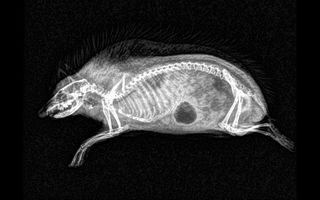Zoo's Animal X-Rays Reveal Spooky, Scary Skeletons
The Oregon Zoo recently posted a series of tweets that included incredible animal X-rays, showcasing the beauty of the zoo's animals on the inside.
From the wings of a flying fox, to a toucan's skull, to the spindly legs of a flamingo, animals' incredible skeletal adaptations are pictured in eerie black and white, offering a Halloween-worthy peek at the bones under layers of skin, muscle and fat. [See X-ray images of the Oregon Zoo animals]
Some of the images show the skeletons in their entirety. Inside the undulating body of a ball python (Python regius), a lengthy chain of vertebrae is framed by ribs running almost the entire length of its sinuous form. Meanwhile, a Rodrigues flying fox (Pteropus rodricensis) lifts its wings overhead, revealing the elongated finger bones inside them.
Other images zoom in for a closer look at animals' exceptional adaptations. In a beaver's broad, flat tail, a line of vertebrae extends almost to the tail's tip, with the individual bones growing ever-smaller as they progress away from the pelvis. An X-ray of the skull of a Cape porcupine (Hystrix africaeaustralis) reveals the heft of its molars and a dramatic curve to its powerful incisors.

To get these extraordinary images, the veterinary staff turned to digital radiography, a type of X-ray imaging that uses digital image-capture technology instead of printing images to film. Digital radiology enables veterinarians and technicians to adjust the exposure in their images after taking them; this means that image capture can happen more quickly, and the animals can spend less time under anesthesia, zoo representatives wrote in a blog post.
The process also allows veterinarians to create a digital archive and easily share X-rays with animal caregivers at other zoos, according to the post. But perhaps most important, digital X-rays provide detailed, high-resolution images, "which helps ensure excellent health care for the animals," zoo representatives said in a statement.
"It also provides a unique glimpse inside the world of wildlife," they added.
Sign up for the Live Science daily newsletter now
Get the world’s most fascinating discoveries delivered straight to your inbox.
Originally publishedon Live Science.

Mindy Weisberger is an editor at Scholastic and a former Live Science channel editor and senior writer. She has reported on general science, covering climate change, paleontology, biology, and space. Mindy studied film at Columbia University; prior to Live Science she produced, wrote and directed media for the American Museum of Natural History in New York City. Her videos about dinosaurs, astrophysics, biodiversity and evolution appear in museums and science centers worldwide, earning awards such as the CINE Golden Eagle and the Communicator Award of Excellence. Her writing has also appeared in Scientific American, The Washington Post and How It Works Magazine.
